At present, there are many researches on indoor positioning at home and abroad. FOXLIN E et al. proposed a traditional navigation mechanism based on the Inertial Measurement Unit (IMU). The walking distance is obtained by integrating the acceleration twice, and the heading change value is obtained by integrating the gyroscope. As a result, a more accurate positioning result is obtained. The basis of its high-precision performance is the expensive IMU, which is not popular in pedestrian positioning; LEVI RW and JUDD T proposed a pedestrian track estimation (Pedestrian Dead Reckoning, PDR) algorithm to achieve pedestrian positioning, which uses acceleration signals to detect When the user walks, the step length is estimated by the relevant model, and the speed, position and distance information of the pedestrian is calculated using the direction information obtained from the gyroscope. The algorithm is simple and the positioning accuracy is higher than that of the traditional inertial navigation mechanism. However, with the increase of time, the error of the sensor continues to accumulate, which makes the PDR positioning accuracy drop sharply after reaching a certain distance; Xie Hongwei and others designed a mobile phone indoor positioning system based on the stability-enhanced particle filter magnetic field matching algorithm. The system realizes positioning under the condition of unknown initial direction and position, and achieves a positioning accuracy of 1 to 2 m. However, the algorithm is complicated to implement and the calculation speed is slow.
Based on the above reasons, this paper proposes a multi-information fusion indoor positioning method based on particle filtering. Through the fusion of PDR and geomagnetic information, the PDR positioning error can be dynamically compensated in real time to achieve a high-precision, low-cost, and low-complexity PDR/geomagnetic fusion indoor Positioning.
1 Fusion positioning algorithmThe PDR algorithm uses inertial devices such as accelerometers, gyroscopes, and magnetometers to obtain the original data when pedestrians are walking. The original data is fused by extended Kalman filtering to obtain the pedestrian's step frequency, step length and direction information. Due to the accumulation of inertial device errors, the positioning error continues to increase, so this article uses geomagnetism to assist PDR to achieve indoor positioning. The principle block diagram is shown in Figure 1.
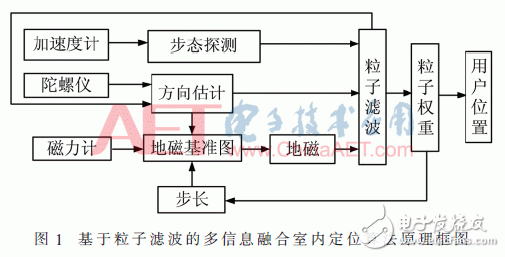
Geomagnetic positioning includes three aspects: one is the establishment of a geomagnetic database in the navigation area; the second is real-time measurement of the magnetometer on the carrier; the third is geomagnetic matching. First, the geomagnetic field characteristics of certain points in the carrier passing area are drawn as a reference map and saved. When the carrier traverses these areas, the similarity of the geomagnetism is used as the benchmark for matching. In this paper, a particle filter algorithm is selected to complete the similarity matching.
2 PDR positioning principleThe basic idea of ​​PDR technology is to obtain the displacement and direction of the carrier per unit time through the acceleration sensor and direction sensor carried by the carrier, so that the position and direction of the carrier at the current time can be calculated according to the position and direction of the carrier at the previous time. If the initial position coordinates are known as (x0, y0), the position coordinates of the k-th step are:

2.1 Gait detection
Step detection methods include zero point detection, peak detection, autocorrelation, step phase detection, zero speed correction, etc. The specific method to be adopted is related to the acceleration installation location. This paper collects data in the normal way of holding a mobile phone, and designs a step frequency detection algorithm based on a sliding window + peak detection of acceleration signals.
The result of the gait detection algorithm is shown in Figure 2. The gait during walking is basically marked, and the accuracy of gait discrimination is close to 100%.
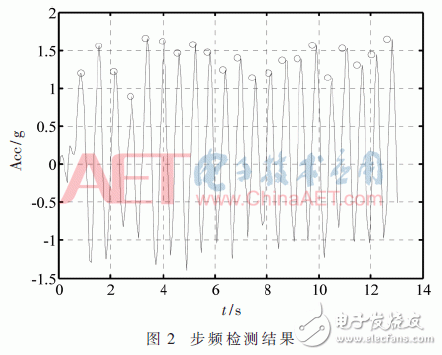
2.2 Step length estimation
There are two main methods of step length estimation in PDR algorithm: one is to integrate the acceleration twice based on the principle of inertial navigation; the other is to use the travel characteristics of people to model their travel distance under specific actions. Most methods based on the step size model use low-cost inertial devices to achieve step size estimation.
In this paper, the PDR algorithm uses a modeling method to determine the pedestrian step length. Assuming that the acceleration change during walking is proportional to the step length, within a cycle, the step length lk of the k-th step can be obtained by the following formula:

Among them, app represents the difference between the peak value and the bottom value of the acceleration, β is the scale factor, and the training data obtained before positioning is obtained by least square fitting.
In order to test the performance of the step-length estimation algorithm, 8 experiments were performed to verify the algorithm. The total length of each tester’s walking is 20 m. Table 1 shows the calculated distances and errors of the 8 sets of data, indicating that the accuracy of the step length estimation algorithm can reach 1 m in a short distance.
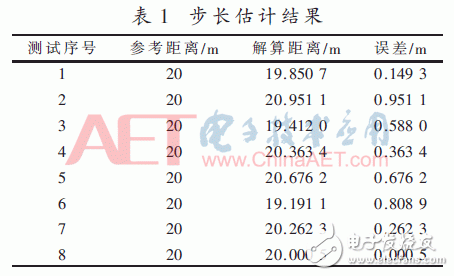
2.3 Direction estimation
For the measurement of the direction angle of pedestrians, low-cost gyroscopes, accelerometers, and magnetometers are commonly used. The zero point of the gyroscope has temperature drift, the accelerometer will be affected by the vibration of the carrier, and the magnetometer will be disturbed by the external magnetic field. Therefore, in order to obtain a reliable and accurate direction angle, filters must be used to fuse data from different sensors and filter out unnecessary interference. This paper chooses the extended Kalman filter to implement the fusion algorithm.
Figure 3 is the pedestrian direction angle obtained by the extended Kalman filter. Due to the existence of the error, the direction angle obtained by the extended Kalman filter still has a certain deviation from the reference direction, and the maximum error is close to 30°.
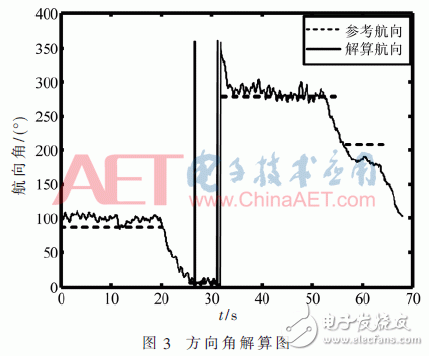
The key to geomagnetic positioning is the geomagnetic matching algorithm, which refers to the process of using geomagnetic maps for navigation and positioning. First, draw the geomagnetic field characteristics of certain points in the area that the carrier passes through as a geomagnetic matching reference map or reference map and save it in the carrier computer. When the carrier traverses these areas, the similarity of the geomagnetism is used as the benchmark for matching, and it is considered the best The matching point is the location of the pedestrian.
3.1 Establishment of geomagnetic reference database
Kriging interpolation is an optimal, linear and unbiased estimation method. It is one of the most widely used spatial interpolation methods. It can maximize the use of the information given and has high interpolation accuracy. Figure 4 is the indoor geomagnetic reference map after Kriging interpolation.
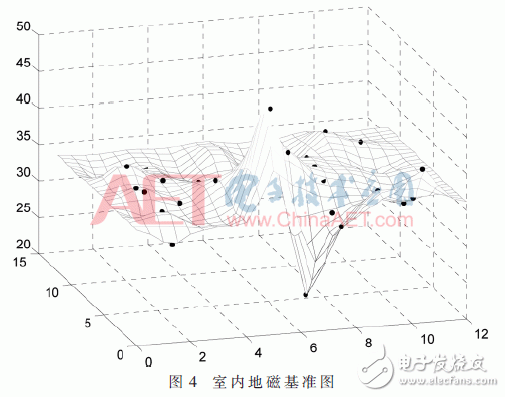
3.2 Particle Filter
Particle filtering is a non-parametric filtering algorithm that uses a limited number of particles to represent the posterior distribution of the state. In the particle filter algorithm, the sampling points of the posterior distribution of the state are called particles. Each particle represents the assumption of the current state. The particle weight is used to measure the probability of the state represented by the particle. The particles are very dense, which means that the probability of the actual state in this area is very high.
The particle filter is mainly composed of state equation, observation equation and resampling. The state equation of this paper is shown in equation (3):
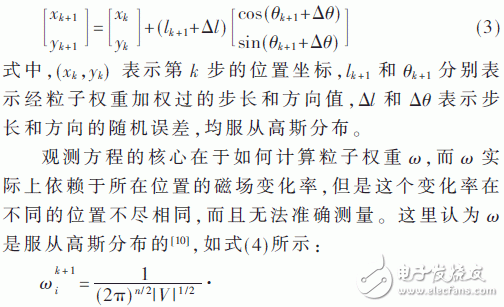

In the formula, n represents the dimension of the observation value z. This article uses the modulus of the magnetic field vector as the observation value, so n=1; V is the covariance; obss represents the geomagnetic value corresponding to the current position obtained by geomagnetic matching; z represents the current position Observed values ​​of geomagnetism.
The PDR algorithm can calculate the step length of pedestrians. However, the error of the step length is relatively large due to the cumulative error of the inertial device. In this paper, the dynamic step length is obtained by setting the initial value of the step length and continuously modifying the particle weight. The step length range of normal people walking is 0.5 m~0.7 m. Assuming the initial value of the step length l0=0.6 m, the step length calculation is shown in formula (5):
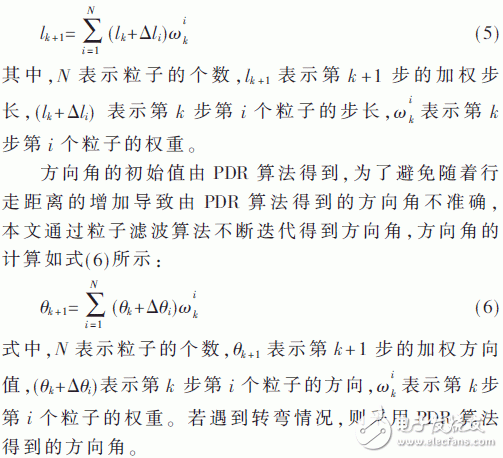
3.3 Resampling
There is the problem of particle degradation in particle filtering. The variance of particle weights increases with time, and the number of effective particles in the state space is less. As the number of invalid sampling particles increases, a lot of calculations are wasted in estimating posterior The filtering probability distribution is almost ineffective on the particles, which makes the estimation performance decrease, and the particle swarm gradually diverges.
The resampling method can effectively solve the problem of particle degradation. When the number of effective particles is less than a certain threshold, the particles are resampled. The idea of ​​resampling is to discard particles with small weights, copy the particles with high weights several times to obtain new particles, and use these new particles to replace the discarded particles. As for the number of times each particle is copied, it is completely determined by the weight of the particle.
4 Experimental results and analysisIn order to verify the feasibility of the multi-information fusion indoor positioning algorithm based on particle filter proposed in this paper, experiments were conducted in an indoor environment. The experimental site is Laboratory 413 on the fourth floor of the University Library. In order to improve the accuracy of magnetic field positioning, the kriging interpolation algorithm is used to perform spatial interpolation on the collected geomagnetic data at 0.5 m intervals. The initial position is known, and the experimenter walks a week along the designated path in the laboratory with a mobile phone in hand. In the process of walking, the mobile phone collects and saves the original data of the accelerometer, gyroscope and magnetometer at a frequency of 20 Hz, and finally the results are simulated by MATLAB software.
This paper compares the results of two positioning algorithms: the first is a pure PDR positioning algorithm based on extended Kalman filtering, and the second is a multi-information fusion indoor positioning algorithm based on particle filtering. Figure 5 is the MATLAB simulation diagram obtained by the two algorithms. It can be seen from Figure 5 that the performance of the fusion indoor positioning algorithm based on particle filter is significantly better than the PDR algorithm. Due to the low accuracy of the inertial device, the direction angle error obtained by the extended Kalman filter increases with the increase of time, which causes the pedestrian trajectory obtained by the PDR to deviate seriously from the actual trajectory. Since the particle filter algorithm can continuously modify the step length and direction angle, this solves the problem of continuous accumulation of errors in PDR. Therefore, as the walking distance increases, the accuracy of the fusion indoor positioning algorithm based on particle filtering can remain stable.
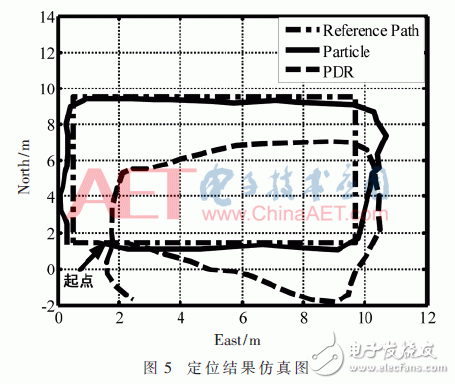
This paper compares the coordinate data of the two simulated trajectories and the reference trajectory, and obtains the errors of the two algorithms, as shown in Table 2.

It can be seen from Table 2 that compared with the PDR algorithm, the algorithm proposed in this paper reduces the average error by 70.5% and the mean square error by 70.8%. The experimental results show that the multi-information fusion indoor positioning algorithm based on particle filter proposed in this paper can solve the problem of accumulation of positioning errors and effectively improve the positioning accuracy.
5 ConclusionIn indoor positioning technology, in order to solve the problems of traditional PDR short-distance high accuracy, long-distance accumulated error and geomagnetic matching easily affected by external interference magnetic fields, this paper proposes a multi-information fusion indoor positioning algorithm based on particle filtering, which passes The dynamic compensation step length and direction angle error effectively suppress the divergence of the positioning results. Experimental results show that the accuracy of the algorithm can reach 1 m~2 m, which verifies the effectiveness and feasibility of the algorithm.
Pneumatic Liquid Level Measuring Device
Pneumatic liquid level measuring device,Pneumatic liquid level measuring device price,Pneumatic liquid level measuring device product
Taizhou Jiabo Instrument Technology Co., Ltd. , https://www.taizhoujbcbyq.com
